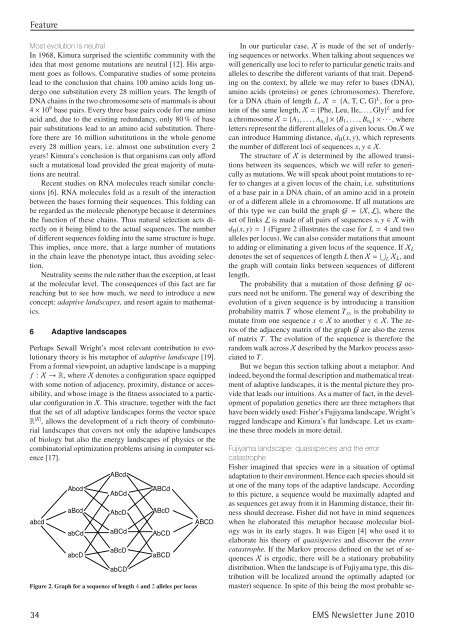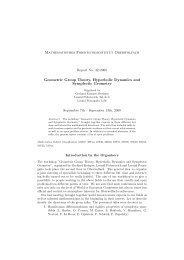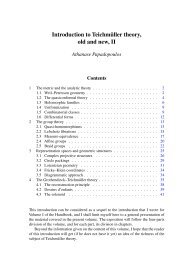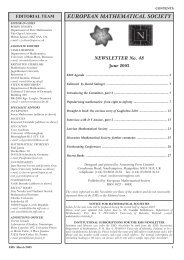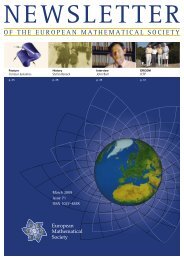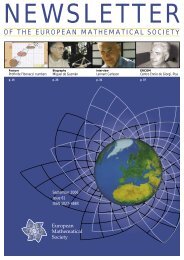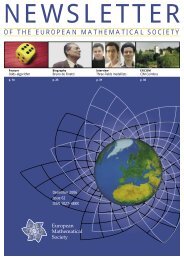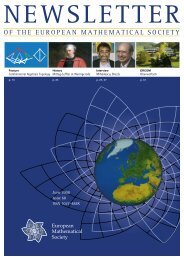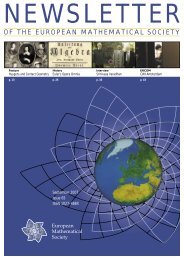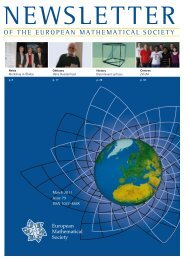EMS Newsletter June 2010 - European Mathematical Society ...
EMS Newsletter June 2010 - European Mathematical Society ...
EMS Newsletter June 2010 - European Mathematical Society ...
You also want an ePaper? Increase the reach of your titles
YUMPU automatically turns print PDFs into web optimized ePapers that Google loves.
Feature<br />
Most evolution is neutral<br />
In 1968, Kimura surprised the scientific community with the<br />
idea that most genome mutations are neutral [12]. His argument<br />
goes as follows. Comparative studies of some proteins<br />
lead to the conclusion that chains 100 amino acids long undergo<br />
one substitution every 28 million years. The length of<br />
DNA chains in the two chromosome sets of mammals is about<br />
4 × 10 9 base pairs. Every three base pairs code for one amino<br />
acid and, due to the existing redundancy, only 80 % of base<br />
pair substitutions lead to an amino acid substitution. Therefore<br />
there are 16 million substitutions in the whole genome<br />
every 28 million years, i.e. almost one substitution every 2<br />
years! Kimura’s conclusion is that organisms can only afford<br />
such a mutational load provided the great majority of mutations<br />
are neutral.<br />
Recent studies on RNA molecules reach similar conclusions<br />
[6]. RNA molecules fold as a result of the interaction<br />
between the bases forming their sequences. This folding can<br />
be regarded as the molecule phenotype because it determines<br />
the function of these chains. Thus natural selection acts directly<br />
on it being blind to the actual sequences. The number<br />
of different sequences folding into the same structure is huge.<br />
This implies, once more, that a large number of mutations<br />
in the chain leave the phenotype intact, thus avoiding selection.<br />
Neutrality seems the rule rather than the exception, at least<br />
at the molecular level. The consequences of this fact are far<br />
reaching but to see how much, we need to introduce a new<br />
concept: adaptive landscapes, and resort again to mathematics.<br />
6 Adaptive landscapes<br />
Perhaps Sewall Wright’s most relevant contribution to evolutionary<br />
theory is his metaphor of adaptive landscape [19].<br />
From a formal viewpoint, an adaptive landscape is a mapping<br />
f : X→R, where X denotes a configuration space equipped<br />
with some notion of adjacency, proximity, distance or accessibility,<br />
and whose image is the fitness associated to a particular<br />
configuration in X. This structure, together with the fact<br />
that the set of all adaptive landscapes forms the vector space<br />
R |X| , allows the development of a rich theory of combinatorial<br />
landscapes that covers not only the adaptive landscapes<br />
of biology but also the energy landscapes of physics or the<br />
combinatorial optimization problems arising in computer science<br />
[17].<br />
abcd<br />
Abcd<br />
aBcd<br />
abCd<br />
abcD<br />
ABcd<br />
AbCd<br />
AbcD<br />
aBCd<br />
aBcD<br />
abCD<br />
ABCd<br />
ABcD<br />
AbCD<br />
aBCD<br />
Figure 2. Graph for a sequence of length 4 and 2 alleles per locus<br />
ABCD<br />
In our particular case, X is made of the set of underlying<br />
sequences or networks. When talking about sequences we<br />
will generically use loci to refer to particular genetic traits and<br />
alleles to describe the different variants of that trait. Depending<br />
on the context, by allele we may refer to bases (DNA),<br />
amino acids (proteins) or genes (chromosomes). Therefore,<br />
for a DNA chain of length L, X = {A, T, C, G} L , for a pro-<br />
tein of the same length, X = {Phe, Leu, Ile,. . . , Gly} L and for<br />
a chromosome X = {A1,...,Ana }×{B1,...,Bnb }×···, where<br />
letters represent the different alleles of a given locus. On X we<br />
can introduce Hamming distance, dH(x, y), which represents<br />
the number of different loci of sequences x, y ∈X.<br />
The structure of X is determined by the allowed transitions<br />
between its sequences, which we will refer to generically<br />
as mutations. We will speak about point mutations to refer<br />
to changes at a given locus of the chain, i.e. substitutions<br />
of a base pair in a DNA chain, of an amino acid in a protein<br />
or of a different allele in a chromosome. If all mutations are<br />
of this type we can build the graph G = {X, L}, where the<br />
set of links L is made of all pairs of sequences x, y ∈Xwith<br />
dH(x, y) = 1 (Figure 2 illustrates the case for L = 4 and two<br />
alleles per locus). We can also consider mutations that amount<br />
to adding or eliminating a given locus of the sequence. If XL<br />
denotes the set of sequences of length L then X = � L XL, and<br />
the graph will contain links between sequences of different<br />
length.<br />
The probability that a mutation of those defining G occurs<br />
need not be uniform. The general way of describing the<br />
evolution of a given sequence is by introducing a transition<br />
probability matrix T whose element Txy is the probability to<br />
mutate from one sequence x ∈Xto another y ∈X. The zeros<br />
of the adjacency matrix of the graph G are also the zeros<br />
of matrix T. The evolution of the sequence is therefore the<br />
random walk across X described by the Markov process associated<br />
to T.<br />
But we began this section talking about a metaphor. And<br />
indeed, beyond the formal description and mathematical treatment<br />
of adaptive landscapes, it is the mental picture they provide<br />
that leads our intuitions. As a matter of fact, in the development<br />
of population genetics there are three metaphors that<br />
have been widely used: Fisher’s Fujiyama landscape, Wright’s<br />
rugged landscape and Kimura’s flat landscape. Let us examine<br />
these three models in more detail.<br />
Fujiyama landscape: quasispecies and the error<br />
catastrophe<br />
Fisher imagined that species were in a situation of optimal<br />
adaptation to their environment. Hence each species should sit<br />
at one of the many tops of the adaptive landscape. According<br />
to this picture, a sequence would be maximally adapted and<br />
as sequences get away from it in Hamming distance, their fitness<br />
should decrease. Fisher did not have in mind sequences<br />
when he elaborated this metaphor because molecular biology<br />
was in its early stages. It was Eigen [4] who used it to<br />
elaborate his theory of quasispecies and discover the error<br />
catastrophe. If the Markov process defined on the set of sequences<br />
X is ergodic, there will be a stationary probability<br />
distribution. When the landscape is of Fujiyama type, this distribution<br />
will be localized around the optimally adapted (or<br />
master) sequence. In spite of this being the most probable se-<br />
34 <strong>EMS</strong> <strong>Newsletter</strong> <strong>June</strong> <strong>2010</strong>


